F-35 Pilot Versus the Machine: USAF Pilot Challenges AI Firm to Fly-Off
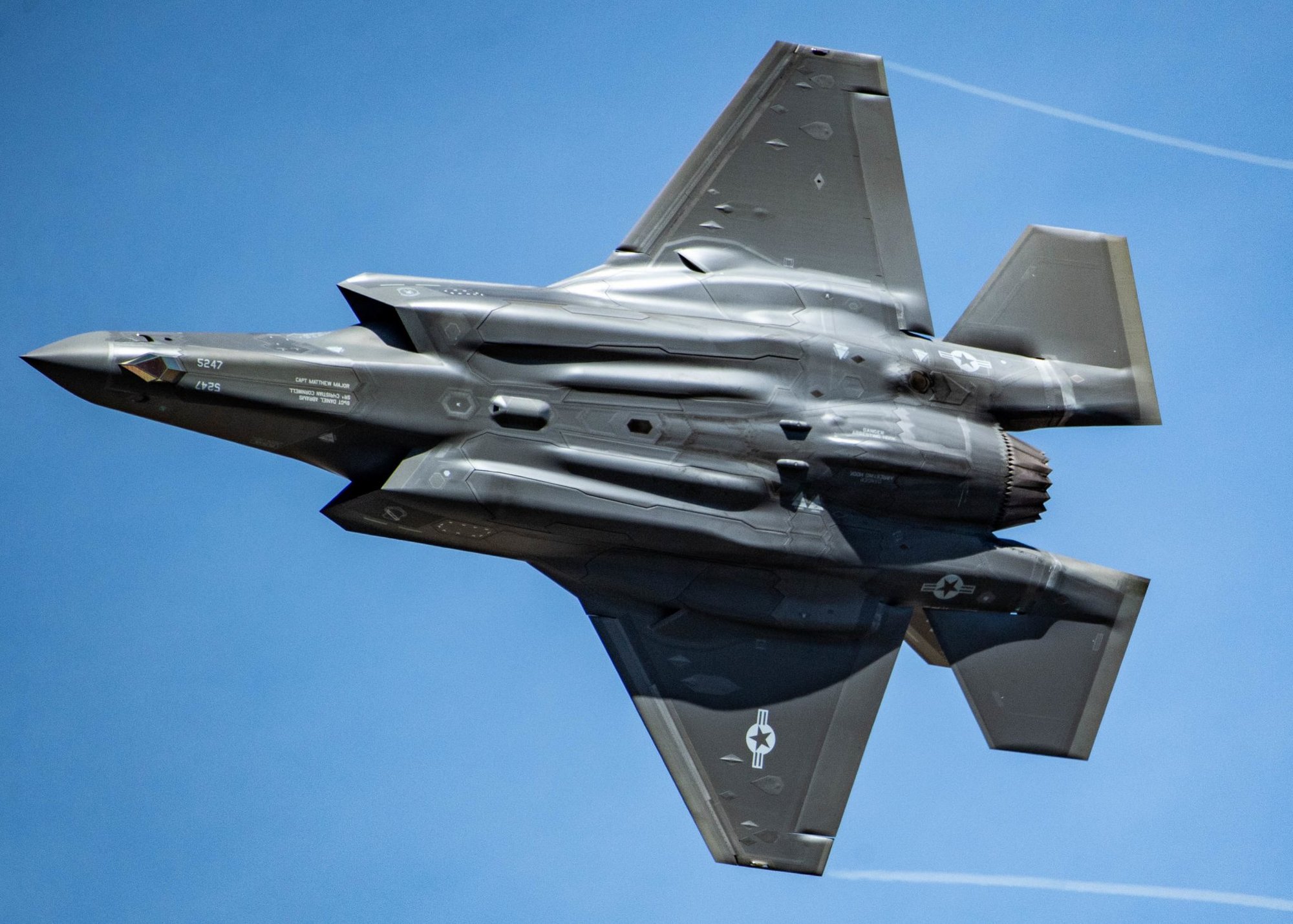
US Air Force Maj. Kristin Wolfe performs a demonstration in the F-35A Lightning II at the Reno Air Races in Reno, Nevada, Sept. 19, 2021. US Air Force photo by Tech. Sgt. Nicolas Myers.
This article by Alex Hollings was originally published Jan. 14, 2022, on Sandboxx News. Follow Sandboxx News on Instagram.
Here at Sandboxx News, we’re known to play favorites when it comes to pilots, so when our friend and contributing writer Hasard Lee reached out to tell us that he recently issued a public challenge to pit him and his F-35 against any fully autonomous aircraft in a complex real–world simulated battlefield environment, we certainly took notice.
Hasard now serves as a major in the U.S. Air Force Reserve, following a lengthy active duty career flying combat missions in the F-16 before transitioning to America’s flying super-computer. To say Hasard is an expert when it comes to the F-35 could be an understatement, as he’s served not only as an instructor training new pilots on how to fly the 5th-generation fighter, he’s also become a sort of unofficial spokesperson for the platform. Hasard has appeared in publications from Popular Mechanics to Business Insider to talk F-35 tech, as well as launching a successful YouTube channel devoted to his passion for aviation and educating the masses.
In the past, Hasard and I have briefly discussed his frustration with the idea that fighter pilots are a thing of the past in this era of artificial intelligence and uncrewed aircraft. He contends, and I’m inclined to agree, that AI just isn’t advanced enough to substitute for the human brain in a complex and dynamic combat environment yet. It might be fair to say that we both know that day may eventually come, but if you ask Hasard, he’ll tell you it won’t be for a long time yet.
“If there is a better way to accomplish a mission, then it is our duty to use it. While I agree with Elon Musk that the future is drone warfare, I think we’re a lifetime away from seeing a fully autonomous Air Force,” Hasard previously wrote.
Which brings us to his public challenge. On Wednesday, Brandon Tseng, Co-founder of Sheild AI, a defense-technology firm that specializes in artificial intelligence, shared a recent op-ed about drone warfare from War on the Rocks with his take on the fighter pilot/drone debate.
Because of an issue embedding the post, I’ll quote it below—but you can check it out by following this link. If you do, please consider that, as passionate about their respective specialties as all involved are, these guys are all professionals who engage with one another as such, and I implore you to follow suit.
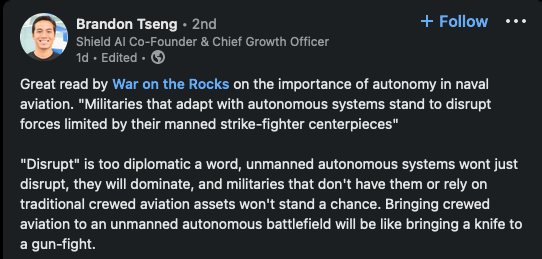
“‘Disrupt’ is too diplomatic a word, unmanned autonomous systems wont just disrupt, they will dominate, and militaries that don’t have them or rely on traditional crewed aviation assets won’t stand a chance. Bringing crewed aviation to an unmanned autonomous battlefield will be like bringing a knife to a gun-fight,” Tseng wrote.
Hasard took a bit of exception to that and promptly issued his challenge in response.
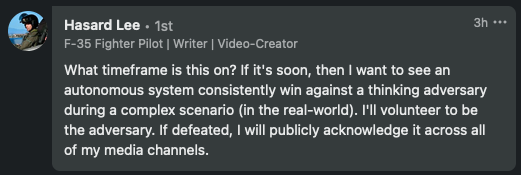
“What timeframe is this on? If it’s soon, then I want to see an autonomous system consistently win against a thinking adversary during a complex scenario (in the real-world). I’ll volunteer to be the adversary. If defeated, I will publicly acknowledge it across all of my media channels.”
It’s important to point out, in order to give the reader appropriate context, that while Hasard is not kidding, he also knows who the good guys are. Hasard’s not looking to take the legs out from under AI ventures or dismiss the value of uncrewed platforms. He’s just trying to unmuddy the waters surrounding this debate with objective and quantitative metrics, rather than extrapolating studies and attributing simulations to reality.
“The proof is in the pudding. If the near future is autonomous air forces battling in the skies above us, then I want to see an autonomous system consistently win against a thinking adversary during a complex scenario in the real world. Just a training exercise–I assure you that however complex the scenario is, it still pales in comparison to a war against a formidable country,” Hasard explained to me.
“I’ll volunteer to be the adversary. If defeated, I will publicly acknowledge it across all media channels. Let’s go further and make a bet with all proceeds going to a veteran charity, because ultimately this is about saving lives and defending our country. The foreseeable future is humans augmented with AI–anyone who thinks otherwise can prove it.”
Drone warfare and “Winged Luddites”
Few facets of warfare better reflect mankind’s rapid technological advancement in the 20th century like aviation. The first heavier-than-air military aircraft in history, a Wright Model A, was purchased by the U.S. Army in August of 1909. Just 32 years later in 1941, the world’s first operational military jet fighter, Germany’s Messerschmitt Me 262 took to the skies. And a mere 23 years after that, the SR-71 Blackbird was screaming through the upper atmosphere at more than 2,400 miles per hour, outrunning missiles and earning its place in the posters on the walls of kids just like me.
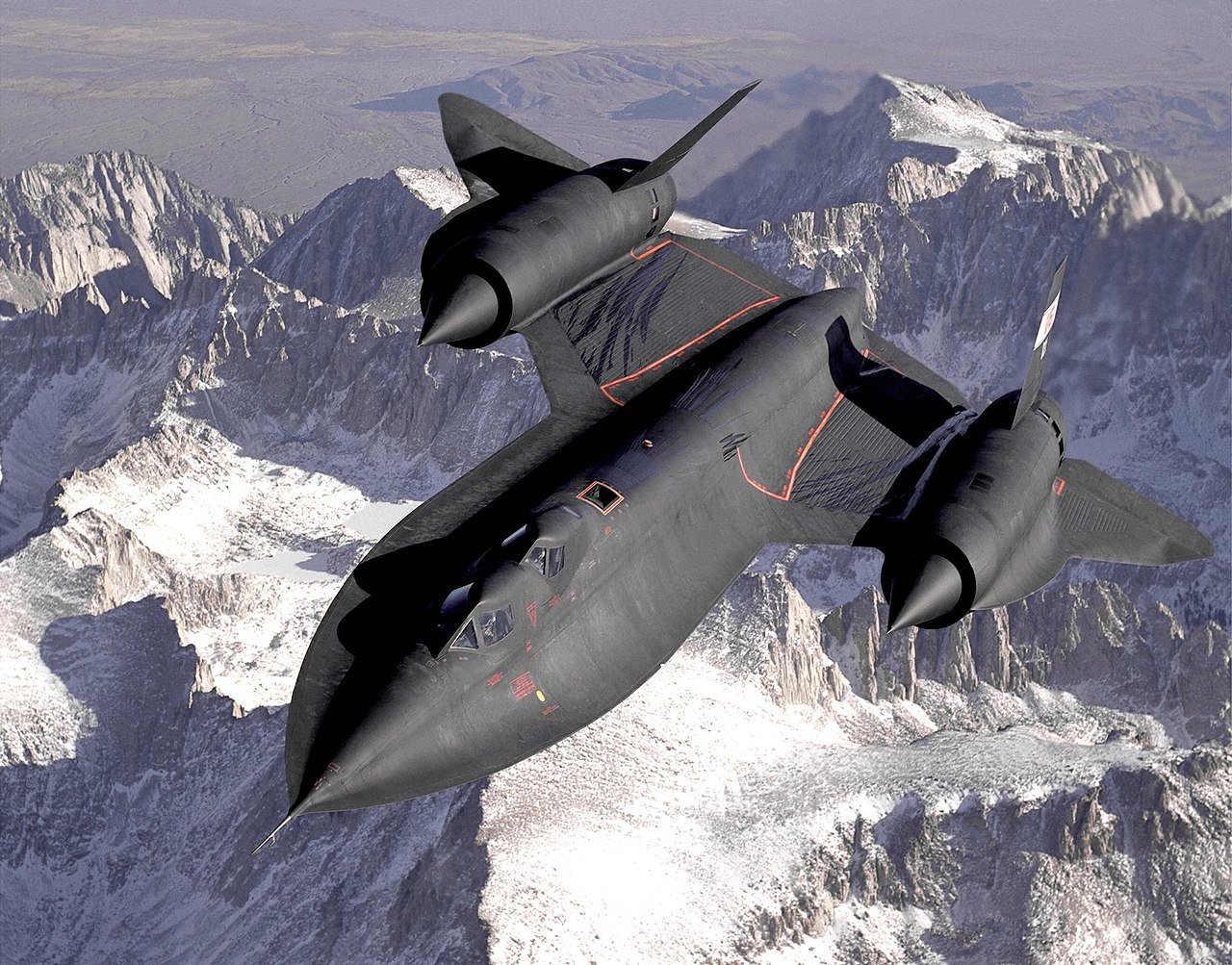
Over the span of a single lifetime, aviation went from bi-planes dropping grenades by hand to the B-2 Spirit stealthily circling the globe with payloads that could lay waste to entire cities. One could contend that aviation, more so than any other realm of war fighting, has long been eager to adopt groundbreaking technology.
Today, programs are underway to marry artificial intelligence and crewed aircraft in ways that could improve the lethality and survivability of tactical aircraft, while efforts like Boeing’s Loyal Wingman aim to surround crewed fighters with constellations of armed semi-autonomous drones taking their cues directly from the pilots. And many have predicted that the Air Force’s forthcoming Next Generation Air Dominance fighter will not be a single fighter at all, but rather a group of systems spread across crewed and uncrewed aircraft alike.
In a world where drones in the air have become ubiquitous within America’s approach to warfare, drone-like systems have yet to find their way into ground or sea-based combat in any significant way. The closest humanity may have come was Russia’s failed attempt to deploy their remotely-controlled Uran-9 infantry support vehicle in Syria. Today, the U.S. Army is developing armed platforms, including tanks, that may find their way into the fight without crews, and of course, the U.S. Navy’s Sea Hunter and other autonomous ships are continuing to rack up successful voyages… But in March of 2019, the MQ-9 Reaper crossed four million flight hours in support of missions all over the world, and it’s the second iteration of the now legendary Predator, with plenty of hours of its own.
It would seem that military aviation, particularly within the United States, isn’t resting on its laurels.
But not everyone sees it that way. In the previously mentioned op-ed published by War on the Rocks, a Marine Unmanned Aircraft Systems Officer and two Navy F/A-18 Super Hornet pilots lay out why they feel U.S. military aviation—particularly within the U.S. Navy—has been irresponsibly slow to adopt autonomous platforms. They argue that the technology to replace crewed fighters has been available for years, but has been hamstrung by a Navy run by fighter jocks who place undue emphasis on the value of human pilots.
“Unfortunately, aviators’ rejection of technological advancements based upon conjecture and preconceived notions is not new. When confronted with overwhelming evidence that does not support established personal beliefs or organizational narratives, there is a natural human disinclination to accept or consider them.”
“Winged Luddites: Aviators Are the Biggest Threat to Carrier Aviation” by Col. Noah “Spool” Spataro, Lt. Cmdr. Trevor “Mrs.” Phillips-Levine, and Lt. Cmdr. Andrew “Kramer” Tenbusch.It’s safe to say these gents knew their story might ruffle a few feathers. After all, they titled it, “Winged Luddites: Aviators Are the Biggest Threat to Carrier Aviation.”
I’m going to touch upon a few points from their piece as we go on, but I recommend that you read their well researched and reasoned arguments for yourself so you can decide where you stand on the topic. While they may harbor a few positions I don’t agree with, you can’t dispute that these men are experts in their fields, and all three have my utmost respect and gratitude for the passion they put into ensuring America meets the threats looming on the horizon with clear eyes.
The Navy does have a serious fighter range problem

While my position on this debate leans closer to Hasard’s than to Colonel Spataro, Lt.Cmdr Phillips-Levine, and Lt. Cmdr Tenbusch (the authors of the aforementioned article) they do raise a number of important points. One that resonated with me in particular was the serious problem presented by China’s use of hypersonic and ballistic anti-ship missiles to create an area-denial bubble that extends perhaps more than a thousand miles from shore.
America’s carrier-based fighters, the F/A-18 Super Hornet piloted by two of the articles’ authors and the Navy variant of the F-35, all lack the range they’d need to fly combat sorties against China without placing their carriers in harm’s way. In fact, I’ve written about this issue a number of times, as well as the multitude of band-aids the Defense Department has tried to use to offset this capability gap, but the fact remains: America’s carriers could be either neutered by location or even sunk by weapons like China’s hypersonic DF-ZF anti-ship glide vehicle carried atop their DF-17 ballistic missile.

The Navy is, in fact, looking to use drones as one of those band aids. The MQ-25 Stingray program began life as a reconnaissance and strike platform before being shifted to focus on mid-air refueling seemingly as the Navy came to recognize this fuel-range issue. It stands to reason that the MQ-25 will eventually find itself carrying some weaponry, but there’s no denying that it is strange that the Navy has been so slow to adopt uncrewed aircraft while the Air Force’s MQ-9, RQ-4, RQ-170 and others have proven not only viable, but invaluable for modern combat operations.
Of course, carrier operations present a number of unique challenges as compared to the airstrips the Air Force has at its disposal, but MQ-9s can be transported by shipping container to austere environments before being deployed, and as the op-ed we’re discussing points out, the Navy has had successful tests with a number of drone platforms aboard its flat tops. Even if the Navy hadn’t already proven they could launch and land drones from their ships, you’ll never convince me that the same service that managed to fly C-130s and U-2 Spy Planes off of their carriers during the Cold War couldn’t find a way to make UAV’s work.
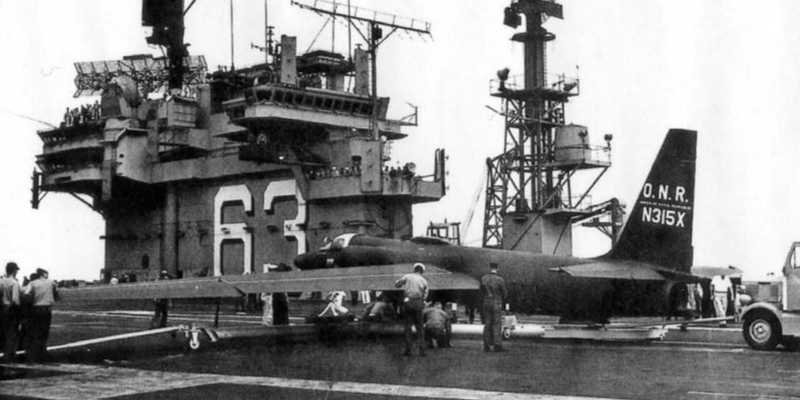
I wouldn’t go so far as to call Navy leaders Luddites (a derogatory term used to describe those who have an aversion to technology) as they did, but if I were given a vote on what the Navy should be investing in, long-range, uncrewed strike aircraft with low-observable designs and attritable-drone price tags would indeed be right at the top of my list.
Is Hasard Lee wrong to say he could beat an autonomous aircraft in a complex real-world scenario?
Drones, like most machines, are exceedingly good at accomplishing simple tasks. Remotely piloted aircraft like the MQ-9 are even better, thanks to a team made up of a trained commissioned pilot and enlisted sensor operator. But my discussions with MQ-9 operators have led me to believe that even remotely piloted aircraft aren’t going to replace crewed platforms any time soon. In fact, that’s exactly what they told me.
“Even with these software improvements and advocating the MQ-9 for the great power competition, we’re still not looking to replace crewed fixed-wing aircraft. We’re looking to augment the team,” An MQ-9 pilot who we’ll call “Dennis” told me in an interview for Popular Mechanics.
While autonomous and remotely crewed aircraft are really good for long-duration missions and airstrike operations in uncontested airspace, they tend to be too slow and sluggish to outmaneuver air defenses, are susceptible to jamming or other interference, and in the case of remotely-piloted platforms, suffer from a brief but meaningful lag (approximately 1.5 seconds each way, for a full 3 second delay at times). It’s important to note that there are efforts underway to mitigate the effects of all of these issues, but the same can be said for any shortcomings we could list for crewed airframes. That’s just the nature of the game.
The officers responsible for the above Op-Ed contend that this can be resolved by using existing platforms, including the F-35, as “autonomous drone mission orchestrators” until technology sufficiently matures to cut Pinocchio’s strings, and I’m inclined to agree. Where we part ways, however, is in their faith in the current state of artificial intelligence.
In August of 2020, I reported on the third round of DARPA’s AlphaDogfight trials, which pitted a highly trained Air Force F-16 pilot against a Heron Systems AI in a digital dogfight that went pretty poorly for Team Meat-Bag. The AI pilot scored five consecutive victories over the human pilot without him ever even getting off a shot. A great deal of that success can certainly be attributed to the AI’s laser-accurate gun runs, which is something Heron’s AI did particularly well, winning out against all of its digital competitors to win a chance at a human in a gaming chair.
“It’s got to keep that opponent in that one degree cone to win the game,” Ben Bell, Heron’s Senior Machine Learning Engineer, told me at the time.
“You saw that a lot with Lockheed, we’re both nose on, we’re both creating damage, but when their nose is off by that one degree, that’s where we were able to win a lot of these engagements.”

This exercise has been pointed to by many as proof positive that it’s time to get the squishy humans out of the cockpit. But like most things, the truth is a bit more complicated than this story is often presented.
The AI proved extremely good at winning a digital fight within the given test parameters that teams spent months preparing for, but that’s a far cry from proving more broadly capable in real world conditions than a human pilot. In fact, no one involved with DARPA’s AlphaDogfight trials came close to making any such claim. Following the AI vs. AI trials DARPA held months prior in November and January left me pretty certain that the teams behind these AI pilots were both brilliant and reaching all the way to the fuzzy edge of what our current technology could do.
“People think military technology outclasses the civilian world. Research and development is what drives innovation. In terms of computers and AI, the civilian world has put a lot more R&D into AI than the military,” Hasard said.
I’ll refrain from making any jokes about how the AI pilot won by doing what many service pilots were quick to point out would immediately end any real life training exercise: it kept playing chicken with its human opponent. But it is worth noting that prioritizing the destruction of the adversary over the survival of the platform in real life is the difference between a drone we can reuse and simply launching a missile. It’s a technique that truly only works in virtual combat. AI will continue to mature and improve, but it seems clear that we’re a long way off from swapping our F-16s for QF-16s.
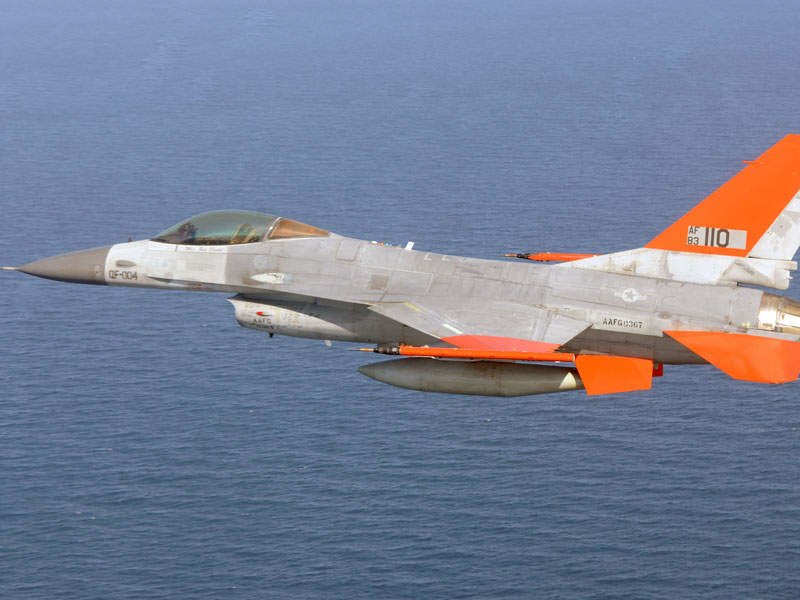
DARPA highlighted that their goal isn’t to replace pilots, but rather to equip them with a highly-capable AI co-pilots, as they also believe the technology simply isn’t mature enough to do away with the human operator altogether.
“Regardless of whether the human or machine wins the final dogfight, the AlphaDogfight Trials is all about increasing trust in AI,” said Col. Dan “Animal” Javorsek, program manager in DARPA’s Strategic Technology Office.
“If the champion AI earns the respect of an F-16 pilot, we’ll have come one step closer to achieving effective human-machine teaming in air combat, which is the goal of the ACE program.”
There are obvious benefits to uncrewed aircraft. AI won’t black out under hard G forces, can take greater risks than procedure would allow for human operators, and have literally digital precision. The problem, folks like Hasard point out, is when the pilot or AI is faced with a rapidly evolving situation that requires creative problem solving. To date, no computer has proven to be as good as fast when it comes to these sorts of decisions as the human brain.
“War is full of fog and friction. There are large unknowns. The enemy is specifically targeting your ability to understand the battlefield. That is where humans completely outmatch computers. AI is great for automating lower-level tasks, but it can’t beat humans in this arena,” Hasard told me.
So, while I can’t help but agree that the Navy is perhaps unnecessarily dragging its rudders on the adoption of unmanned aerial vehicles… I’d still put my money on Hasard and his F-35 in a real-life combat situation with complex problems to solve. The Navy needs to get on board with UAVs, but it’s also going to be stuck with skilled, capable, and courageous aviators like Mrs. and Kramer for some time to come.
As for Hasard taking on an autonomous platform in a real-world sparring match? My money’s on the side I share a genome with, and the evidence seems to suggest that if it’s a fight held any time this decade, that’s a pretty smart bet. And that’s not just because he sent me a neat F-35 patch. But it helps.
I’m not one of those guys who believes we’ll always need a Wesley Crusher at the helm even after Data shows up on the bridge. In fact, I think America needs to be investing heavily in autonomous systems because they are, indeed, the future. And there’s the rub… we’re just not quite there yet.
“The future is not one or the other. The future is both working together seamlessly. The sooner we can dismiss the zealots arguing for one extreme or the other, the sooner we can provide warfighters with the best capabilities,” Hasard said.
Read Next: When This WWII Ace Ran Out of Ammo, He Rammed his Plane into a German Fighter

Sandboxx News provides the latest news, entertainment, and motivation from all around the force.
BRCC and Bad Moon Print Press team up for an exclusive, limited-edition T-shirt design!
BRCC partners with Team Room Design for an exclusive T-shirt release!
Thirty Seconds Out has partnered with BRCC for an exclusive shirt design invoking the God of Winter.
Lucas O'Hara of Grizzly Forge has teamed up with BRCC for a badass, exclusive Shirt Club T-shirt design featuring his most popular knife and tiomahawk.
Coffee or Die sits down with one of the graphic designers behind Black Rifle Coffee's signature look and vibe.
Biden will award the Medal of Honor to a Vietnam War Army helicopter pilot who risked his life to save a reconnaissance team from almost certain death.
Ever wonder how much Jack Mandaville would f*ck sh*t up if he went back in time? The American Revolution didn't even see him coming.
A nearly 200-year-old West Point time capsule that at first appeared to yield little more than dust contains hidden treasure, the US Military Academy said.












